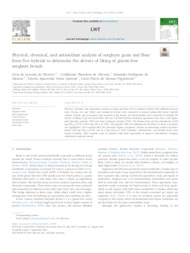Physical, chemical, and antioxidant analysis of sorghum grain and flour from five hybrids to determine the drivers of liking of gluten-free sorghum breads.
Physical, chemical, and antioxidant analysis of sorghum grain and flour from five hybrids to determine the drivers of liking of gluten-free sorghum breads.
Autoria: OLIVEIRA, L. de L. de; OLIVEIRA, G. T. de; ALENCAR, E. R. de; QUEIROZ, V. A. V.; FIGUEIREDO, L. F. de A.
Resumo: Physical, chemical, and antioxidant analysis of grain and flour of five sorghum hybrids with different pericarp color (brown, red, and white) and endosperm texture were conducted to prepare gluten-free bread. Specific volume, texture, and acceptance were assessed in the breads. All characteristics were correlated to identify the drivers of liking. Only the brown BRS 305 and 1167048 hybrids presented pigmented testa layer with higher total phenolic contents (TPC) and total condensed tannins (TAN). The former stood out for antioxidants (1493 mg/100 g of TPC, 609.9 mg/100 g of TAN). The negative effect of antioxidants and fibers on bread acceptance was highlighted. Red sorghum BRS 332 presented higher acceptance, besides an interesting content of antioxidants (218 mg/100 g of TPC and 21.4 mg/100 g of TAN). Proteins, carbohydrates, and soluble starch were drivers of liking. Their contents could be adjusted with other ingredients to improve formulations of higher antioxidant sorghum breads.
Ano de publicação: 2022
Tipo de publicação: Artigo de periódico
Unidade: Embrapa Milho e Sorgo
Palavras-chave: Acceptance drivers, Alimento, Amido, Antioxidant foods, Antioxidante, Breads, Farinha, Flour trait, Gluten-free foods, Glúten, Grain diversity, Grão, Pão, Sorgo
Observações
1 - Por padrão são exibidas publicações dos últimos 20 anos. Para encontrar publicações mais antigas, configure o filtro ano de publicação, colocando o ano a partir do qual você deseja encontrar publicações. O filtro está na coluna da esquerda na busca acima.
2 - Para ler algumas publicações da Embrapa (apenas as que estão em formato ePub), é necessário ter, no celular ou computador, um desses softwares gratuitos. Sistemas Android: Google Play Livros; IOS: iBooks; Windows e Linux: software Calibre.
Acesse outras publicações
Acesse a Base de Dados da Pesquisa Agropecuária (BDPA) para consultar o acervo completo das bibliotecas da Embrapa.

